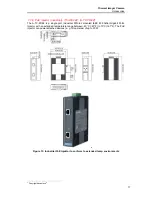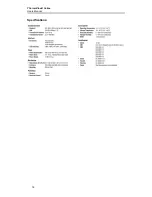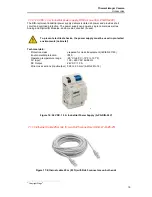
ThermoView® Series
Users Manual
4
2.1. System Architecture
Figure 2: Typical System Architecture for Multi ThermoView
®
Camera Usage
Figure 3: Identification matrix for ThermoView
®
infrared cameras
X
0 1
---
Y
0 L V
Y
0 T T
---
Y
L
X
3 6
4
4
V
V
T
T
M
od
el
Id
en
tif
ic
at
io
n M
at
rix
F
or
T
he
rm
oV
ie
w
®
-S
er
ie
s De
vic
es
By
De
fin
ed
Nu
m
be
rin
g T
re
e
X
=
N
umb
er
Y
=
C
ap
ital
IR
came
ra
fr
ame
rate
=
9H
z
(fp
s)
Sp
ar
e
Th
er
mo
Vi
ew®
came
ra
on
ly
(n
o
SW
in
cl
ud
ed
)
Th
er
mo
Vi
ew®
came
ra
wi
th
"
Th
er
mo
Vi
ew®
Var
iety
So
ftwar
e"
ThermoView® SW Identifier (0, T, T)
Unique Thermo
V
iew® Series Identifier
Temperature Range (L)
Camera Model (3 / 6 as sensor array resolution identifier)
Unique ThermoView® Series Sub-item Identifier
Unique
T
hermoView® Series Identifier
Frame rate ident. (0, 1)
IR
came
ra
fr
ame
rate
=
60H
z
(fp
s)
Fi
xed
d
efi
ned
"
T"
fo
r
T
her
mo
Vi
ew®
ser
ies
devi
ces
→→→
Fi
xed
d
efi
ned
"
V"
fo
r
Th
er
mo
V
iew®
ser
ies
devi
ces
Sp
eci
fic
su
b-i
tem
in
di
cato
r
fo
r
Th
er
mo
Vi
ew®
ser
ies
devi
ces
6:
In
fr
ar
ed
th
er
mal
sen
so
r
ar
ray
reso
lu
tio
n
=
640
X
480
p
ixel
(8-14
µm)
3:
In
fr
ar
ed
th
er
mal
sen
so
r
ar
ray
reso
lu
tio
n
=
320
X
240
p
ixel
(8-14
µ
m)
ThermoView® SW Identifier (0, L, V)
Th
er
mo
Vi
ew®
came
ra
wi
th
"
Th
er
mo
Vi
ew®
Li
te
So
ftwar
e"
Lo
w
Temp
er
atu
re
R
an
ge
(0
to
120
0°
C
/
32
to
219
2°
F)
PoE Ethernet Switch
Windows Computer
with ThermoView
®
camera Software
Digital I/O
Analog I/O
GigE Vision Communication
(optional Fiber Optic)
TV46 Camera
TV43 Camera


























